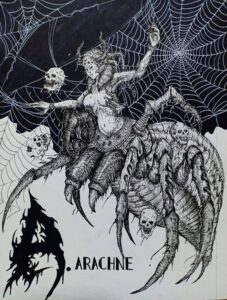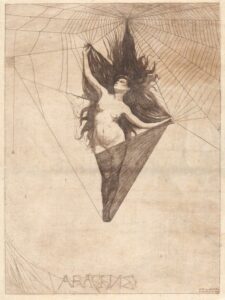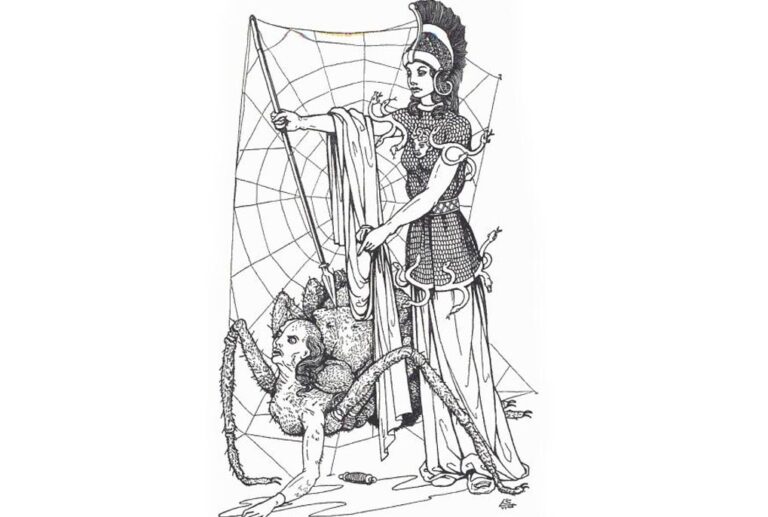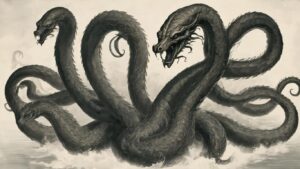Table of Contents
Who is Arachne
In Greek mythology, Arachne was a mortal woman who was known for her exceptional skill in weaving. She became famous for claiming that her weaving abilities surpassed even those of the goddess Athena, the goddess of wisdom, crafts, and war.
According to the myth, Athena challenged Arachne to a weaving contest to determine who was the superior weaver. The contest was held, and both Athena and Arachne created stunning tapestries. However, Arachne’s tapestry depicted the gods in a less-than-flattering light, showcasing their flaws and mistakes. This angered Athena, who, in a fit of rage, destroyed Arachne’s work.
In some versions of the myth, Athena, feeling both anger and pity for Arachne, transformed her into a spider as a punishment. This is how Arachne became associated with spiders in Greek mythology. The name “Arachne” is also the origin of the word “arachnid,” which is a class of joint-legged invertebrates that includes spiders.
The myth of Arachne serves as a cautionary tale about hubris and the consequences of challenging the gods.
Appearance

The physical appearance of Arachne is not consistently described in Greek mythology. Different accounts may provide varied details, and in some versions of the myth, her appearance might not be emphasized. Generally, Greek mythology tends to focus more on the actions and deeds of characters rather than their physical attributes.
In the myth of Arachne, the emphasis is on her skill in weaving and the challenge she poses to the goddess Athena. The transformation into a spider is the central aspect of her story, symbolizing the consequence of her pride and defiance towards the gods. As a spider, Arachne is associated with her weaving skills and the creation of intricate webs.
Family
In classical Greek mythology, the family background of Arachne is not always explicitly detailed, and different versions of the myth may provide varying information. Generally, she is portrayed as a mortal woman with exceptional weaving skills. Some versions of the myth mention that she was the daughter of a common dyer or shepherd.
The emphasis in the Arachne myth is often on her contest with the goddess Athena and the subsequent punishment that leads to her transformation into a spider. As a result, her family background is not as prominently featured in the narrative.
Greek mythology has numerous variations and interpretations, and different sources may provide different details about the characters and their backgrounds.
Origin and History

The myth of Arachne is a part of Greek mythology and has been passed down through various sources, including ancient texts and oral traditions. The most well-known version of the story is found in Ovid’s “Metamorphoses,” a Latin narrative poem written in the first century BCE. In Book VI of the “Metamorphoses,” Ovid recounts the tale of Arachne and her weaving contest with Athena.
According to Ovid’s version, Arachne was a mortal woman from Lydia who gained fame for her exceptional weaving skills. She became proud and boasted that her abilities surpassed even those of the goddess Athena. This arrogance led to a weaving contest between Arachne and Athena. Despite creating a magnificent tapestry, Arachne depicted the gods in a negative light, leading to Athena’s anger.
Athena, in her rage, tore apart Arachne’s tapestry, and in some versions, even struck Arachne. Facing the consequences of her hubris, Arachne was transformed into a spider. Ovid’s narrative is rich in detail and explores themes such as hubris, divine punishment, and metamorphosis—common elements in Greek mythology.
The story of Arachne has been retold and adapted by various authors and artists over the centuries, contributing to its lasting cultural significance. It serves as a cautionary tale about the consequences of challenging the gods and the importance of humility. The motif of a mortal challenging a deity and facing a transformation as punishment is a recurring theme in Greek mythology and other mythological traditions.
Modern Influence

The myth of Arachne has had a lasting influence on literature, art, and popular culture, and its themes continue to resonate in modern storytelling. Here are a few ways in which the story of Arachne has left its mark:
Literature and Poetry: The tale of Arachne has inspired numerous works of literature. Writers have explored themes of hubris, transformation, and the consequences of challenging the divine in their own unique ways. The myth’s enduring qualities make it a rich source for reinterpretation.
Art and Visual Arts: The story of Arachne is a popular subject in visual arts, including paintings, sculptures, and illustrations. Artists throughout history have been drawn to the narrative’s dramatic elements, from the weaving contest to Arachne’s transformation into a spider. This myth provides a powerful visual metaphor that continues to captivate audiences.
Metaphorical Use: The name “Arachne” and the associated theme of weaving have been metaphorically used in various contexts. The idea of weaving is sometimes employed to represent the interconnectedness of events or ideas, while the figure of Arachne can symbolize the consequences of human pride or the pursuit of excellence.
Symbolism in Science: The word “arachnid” is derived from the name Arachne, reflecting her transformation into a spider. This term is used in biology to refer to a class of joint-legged invertebrates that includes spiders. The connection between the myth and the scientific classification adds an interesting layer to the cultural impact of the story.
Adaptations in Popular Culture: Elements of the Arachne myth can be found in various modern works, including literature, films, and television. Writers and filmmakers often draw on classical mythology for inspiration, and the themes of transformation and divine consequences continue to be relevant and compelling in contemporary storytelling.
The enduring nature of the Arachne myth highlights its universal themes and the ability of ancient stories to resonate across time and cultures. As with many myths, the narrative of Arachne continues to evolve and find new expressions in the ever-changing landscape of human creativity.
Arachne FAQ
Who is Arachne?
In Greek mythology, Arachne was a mortal woman known for her exceptional skill in weaving. The most well-known version of her story is found in Ovid's "Metamorphoses." Arachne, the daughter of a common dyer or, in some versions, a man named Idmon of Colophon, became renowned for her weaving talents and, eventually, for her pride.
Arachne claimed that her skills surpassed even those of the goddess Athena, the patroness of crafts and wisdom. To test this boast, Athena challenged Arachne to a weaving contest. Both Arachne and Athena created intricate tapestries, but Arachne's depicted the gods in a less-than-flattering light. Athena, angered by Arachne's disrespect, destroyed her tapestry.
Why did Athena turn Arachne into a spider?
Athena turned Arachne into a spider as a punishment for Arachne's hubris and disrespect toward the gods. According to the myth in Ovid's "Metamorphoses," Arachne, a mortal woman known for her exceptional weaving skills, claimed that she could weave better than the goddess Athena. In response to Arachne's boast, Athena challenged her to a weaving contest.
During the contest, both Athena and Arachne created intricate tapestries. Arachne's tapestry, however, depicted the gods in a negative light, showcasing their flaws and mistakes. This angered Athena, who, in her rage, destroyed Arachne's work. Despite Arachne's exceptional skill, she had overstepped the boundaries of respect toward the gods.
In some versions of the myth, Athena, feeling both anger and pity for Arachne, transformed her into a spider. This punishment not only served as a consequence for Arachne's pride and disrespect but also reflected Athena's role as a goddess associated with crafts and wisdom. The transformation into a spider condemned Arachne to spend the rest of her existence weaving webs, symbolizing her eternal punishment for challenging the divine.
What did Athena do after the weaving contest between her and Arachne?
After the weaving contest between Athena and Arachne, Athena responded to Arachne's disrespectful depiction of the gods in a couple of different ways, depending on the version of the myth. In Ovid's "Metamorphoses," the most well-known source for the story, Athena, angered by Arachne's tapestry, destroyed it. Some versions also mention that Athena struck Arachne or tore the mortal weaver's work to shreds in her fury.
Athena then confronted Arachne, making her realize the gravity of her hubris and the consequences of challenging the gods. In some versions, Athena decided to spare Arachne from a harsher punishment—perhaps out of a mix of anger and pity. Instead of causing her direct harm or death, Athena transformed Arachne into a spider.
This transformation was both a punishment and a form of mercy. Arachne retained her weaving skills but was now condemned to weave webs for the rest of her existence. The transformation into a spider symbolizes the eternal nature of her punishment, and it's a common theme in Greek mythology where metamorphosis serves as a significant aspect of divine justice.
What is the theme of Arachne?
The story of Arachne encompasses several themes common in Greek mythology. Key themes:
Hubris and Pride: Arachne's downfall is primarily a result of her excessive pride and boastfulness. Her claim that she could weave better than the goddess Athena and her disrespectful portrayal of the gods in her tapestry highlight the theme of hubris—the dangerous overestimation of one's abilities.
Divine Retribution: The myth illustrates the concept of divine justice and retribution. Arachne's actions anger the goddess Athena, leading to a punishment that befits the offense. This theme reinforces the idea that challenging or disrespecting the divine has consequences.
Craftsmanship and Skill: Arachne's exceptional weaving skills are central to the story. The weaving contest between Arachne and Athena emphasizes the theme of craftsmanship and skill. It explores the idea that talent, even when extraordinary, should be accompanied by humility.
Metamorphosis: The transformation of Arachne into a spider is a classic example of metamorphosis, a recurring theme in Greek mythology. The change in form serves as both a punishment and a symbol of the eternal consequences of her actions. Metamorphosis often signifies a profound transformation resulting from one's choices.
Creative Competition: The weaving contest between Arachne and Athena introduces the theme of creative competition. While competition can be a driving force for excellence, the story suggests that there are limits, especially when it involves challenging divine entities.
Legacy and Symbolism: The association of Arachne with spiders and weaving has led to her becoming a symbol in various cultural contexts. The theme of legacy is present as the story suggests that all spiders in the world are Arachne's offspring, creating a lasting impact.
These themes collectively contribute to the moral and cautionary aspects of the myth of Arachne, making it a rich and layered narrative with lessons about humility, respect for the divine, and the consequences of unchecked pride.
Which archetype fits the character Arachne best?
The character of Arachne in Greek mythology can be associated with the archetype of the "Tragic Heroine" or the "Hubristic Figure." Archetypes are recurring patterns or symbols in literature and mythology that represent universal themes or character types. Here's why the "Tragic Heroine" or "Hubristic Figure" archetype fits Arachne:
Tragic Heroine:
Hubris and Downfall: Arachne's tragic flaw is her hubris, excessive pride, and arrogance. Her belief that she could surpass the goddess Athena in weaving led to her downfall.
Catharsis: The audience may experience catharsis, a purging of emotions, as they witness Arachne's tragic fate. Her transformation into a spider serves as a moment of intense emotional release.
Hubristic Figure:
Hubris Leading to Punishment: Arachne's hubris is a central element of her character. She challenges a divine being, Athena, and disrespects the gods in her artwork, leading to a punishment that fits her transgressions.
Cautionary Tale: The archetype of the hubristic figure often serves as a cautionary tale, warning against the dangers of pride and overestimating one's abilities. Arachne's story conveys this moral lesson.
Arachne's character embodies the consequences of defying the divine, and her narrative aligns with the structure often found in tragic tales. The archetype of the Tragic Heroine or Hubristic Figure helps to highlight the universal themes of the story and the moral lessons it conveys about the repercussions of unchecked pride.
Why did Arachne kill herself?
In classical Greek mythology, there is no widely known version of the Arachne myth that includes Arachne killing herself. The most common narrative, as recounted by Ovid in his "Metamorphoses," tells of Arachne being transformed into a spider by the goddess Athena as a punishment for her hubris and disrespect towards the gods.
The theme of suicide or self-harm is not typically associated with Arachne's story in classical mythology. Different variations of myths exist, and it's possible that in some lesser-known versions or interpretations, the narrative details might differ. However, the predominant and well-known account involves Arachne's transformation into a spider, symbolizing her eternal punishment for challenging the divine.




